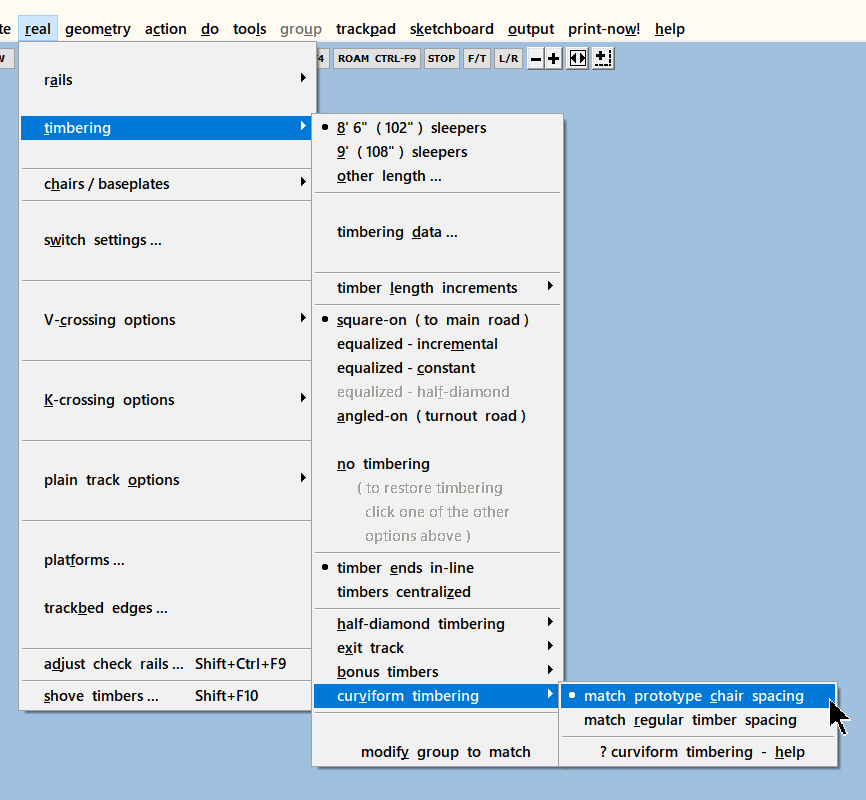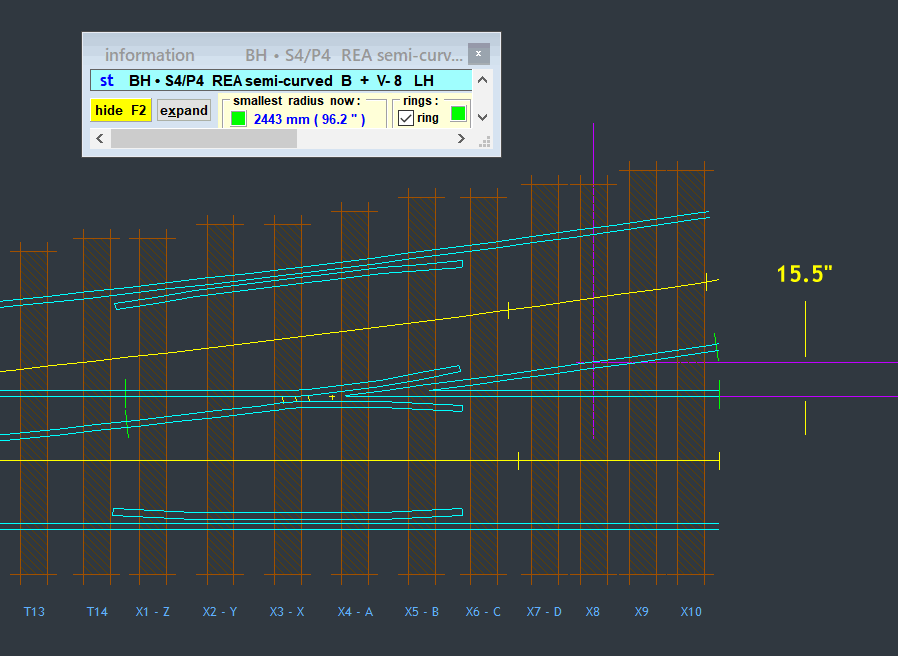Templot Club Archive 2007-2020
|
|||
| author | remove search highlighting | ||
|---|---|---|---|
|
posted: 30 Aug 2017 03:30 from: Martin Wynne
click the date to link to this post click member name to view archived images |
Dear all, There's a detail in Templot which has been niggling away at me for years. No-one has ever mentioned it, but I have finally decided to do something about it. The REA special crossing chairs for each crossing angle are designed for timbers spaced at the standard spacing of 30", and with the vee rails separating at a rate determined solely by the crossing angle. Which is true in the case of regular and generic type V-crossings. Such combined crossing chairs are needed where the rail separation across the rail heads is less than about 15". Beyond that two ordinary chairs can be used to hold the vee rails in most cases. However, in the case of curviform type V-crossings it is not true. Because the turnout curve continues along the diverging rail, that rail separates from the main rail more rapidly than is the case for regular V-crossings. The crossing chairs are designed for fixed rail separations, and it follows therefore that in a curviform crossing the standard crossing chairs will not fit the rails at 30" spacings. In the past I have assumed that in practice the gang would deal with this either by moving the chairs by a fraction on the timber, or where that is insufficient by using chairs intended for a shorter crossing angle. There is a huge range of crossing chairs available bearing in mind that two or three sizes are needed at every standard crossing angle, so it's very likely that one having the required rail separation could be found. But it is equally possible that the design office would specify timbers for a curviform crossing in a complex formation at the actual required closed-up spacing. Which is straightforward enough, but would leave a large gap between the last such closed-up timber and the joint timber at the end of the vee rails. It's possible that this gap would be dealt with by shortening the vee rails, but that means a non-standard vee assembly which can't be replaced quickly when needed. An additional timber seems the more likely practice to provide full rail support. So in the next program update I have added a new option for this in the Templot timbering. This is a 1:8 crossing in P4: 2_291459_550000000.png  You can see that in the curviform case the X6, X7 and X8 timbers have been moved back towards the vee nose, and an additional X9 timber used to fill the wide gap between X8 and X10. The resulting variable timber spacing doesn't look as neat as fixed 30" spacing, but if you look at real track you soon notice that a neat 30" constant spacing is often lacking. This option will be off by default, but can be turned on when wanted: 2_292023_500000000.png  and changed for all an existing trackplan using the modify group to match function. Just to repeat that this option applies only to curviform V-crossings. Regular and generic V-crossings are not affected. regards, Martin. |
||
|
posted: 30 Aug 2017 11:27 from: Judi R
click the date to link to this post click member name to view archived images |
03:30? More midnight oil being burnt here Martin! When I served my apprenticeship in the P Way design office at Stephenson House all those years ago I remember being able to specify the rail spacing required for bespoke layouts, we always used standard sleeper spacing. I also remember being shown the pattern shop at Taylor Brothers' Sandiacre works where they had wooden patterns for every rail section they had ever had to use. They were able to adjust the spacing of the jaws for a double chair to suit. Of course, when vertical flatbottom design came along, we simply had to specify the overall width of the rail seat and we would specify a mid Pandrol clip housing whenever we could. Judi |
||
|
posted: 30 Aug 2017 13:18 from: Martin Wynne
click the date to link to this post click member name to view archived images |
Judi R wrote: I also remember being shown the pattern shop at Taylor Brothers' Sandiacre works where they had wooden patterns for every rail section they had ever had to use. They were able to adjust the spacing of the jaws for a double chair to suitThanks Judi. Are you saying that whenever a crossing was laid curviform, special chair castings would be provided? Even say when the gang are laying out sidings in a goods yard from second-hand material? I have tweaked the maths a little to make the spacings a bit less discontinuous: 2_300755_320000000.png  A 1:8 crossing normally has just two crossing chairs beyond the "B" chair, on the "C" and "D" timbers, bridge chairs being used on one or both sides beyond there. A standard L1 bridge chair requires 7" clear from the rail running edge on the key side, so allowing for an angle between them we can see where the 15" separation limit comes from, below which the special crossing chairs are needed. (L1 chairs can get quite a bit closer if you turn them round and use them inside-keyed, but that is avoided as far as possible because of the rail inclination.) The X8 timber above has 15.5" separation at the position shown, so two bridge chairs will fit, and the timber position isn't tightly controlled by the chair design. It can move a bit to even out the spacings, provided the separation doesn't go below say 14.5". I doubt the gang would go into all this maths -- a bit of chalk and a big hammer seem more likely. regards, Martin. |
||
|
posted: 31 Aug 2017 10:18 from: Judi R
click the date to link to this post click member name to view archived images |
Martin, it seems like a hundred years ago since I was in the design office but my memory is that we would use standard straight common crossings unless we were designing a complex junction. Of course a model railway will often need to make compromises and we all love complex trackwork! Judi |
||
| Please read this important note about copyright: Unless stated otherwise, all the files submitted to this web site are copyright and the property of the respective contributor. You are welcome to use them for your own personal non-commercial purposes, and in your messages on this web site. If you want to publish any of this material elsewhere or use it commercially, you must first obtain the owner's permission to do so. |